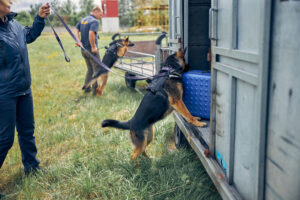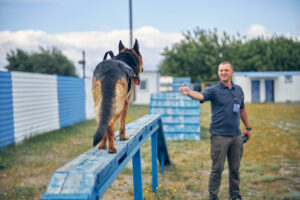






At first glance, it sounds like a paradox, doesn’t it? Taking a dog bred for vigilance and courage, and reshaping it into one defined by calmness and care.
Can a protector, trained to hold the line and guard a perimeter, transform into a steady companion—one attuned to the daily needs of a person seeking not just safety, but support?
Before diving in, let’s clarify what we mean by a service dog. In this context, we’re talking about dogs specifically trained to assist individuals with disabilities, making daily life more manageable.
And what about protection dogs? These are dogs trained for protection, vigilance, deterrence, and defense. They’re conditioned to respond swiftly and decisively to threats, with instincts fine-tuned for detecting danger.
Now, the questions start to pile up. Aren’t protection dogs too reactive? Surely instincts don’t vanish overnight, right?
Maybe you’re skeptical, curious, or even questioning whether this is asking too much—of the dogs, the trainers, or the process itself.
It’s a fair inquiry. And the answer? It’s far from simple.
Let’s unpack it together.
Two different worlds….
| Aspect | Service Dog | Protection Dog |
|---|---|---|
| Purpose | From guiding to alerting, they bring comfort, independence, and support to individuals with psychological and/or physiological disabilities. | Ensures safety in high-risk situations —with everything from intimidating barks to physical intervention to deter or neutralize threats. |
| Training | Flexible. Some are professionally trained; others are taught by their owners. | Non-negotiable: professional training only. These dogs need precision, discipline, and expertise that can’t be replicated without years of experience. |
| Behavior and Temperament | Calm, approachable, and downright friendly. They’re happy to accept a pat from a stranger and stay laser-focused on their job—helping, not protecting. | Not approachable. Strangers? Keep your hands to yourself. Maintains a calm yet vigilant demeanor, ready to defend if necessary. |
| Physical Demands | Moderate. | High. |
| Public Access | Full access, no questions asked. Hospitals, restaurants, grocery stores, hotels—you name it. These dogs go wherever their handler needs them. | Limited access, typically restricted to open public spaces like parks and streets. |
…. Yet, these worlds, while seemingly incompatible, sometimes overlap. Not often, but sometimes.
You see, the qualities that make a protection dog so extraordinary—its intelligence, its discipline, its focus, its loyalty, its temperament, its trainability—also make an exceptional candidate for service.

You’re not just about changing a dog’s job; you’re reshaping its instincts, reworking its reactions, and refining its role in a way that honors both its natural abilities and its new purpose.
At the heart of this transformation lies temperament–a dog’s innate personality and disposition. This single factor often determines whether this leap is possible.
Some protection dogs like Rottweilers are naturally too intense—too focused on their role as defenders to adapt to the softer, more empathetic requirements of a service dog.
Others like the Great Danes, however, carry a quiet composure beneath their vigilant exteriors, making them candidates for this transformation.
The difference is that – with the right training and with the right dog – you can have both: a protection dog and a service dog.
It starts with breaking habits. No, not breaking the dog—that’s a misunderstanding of how training works.
Instead, professional trainers carefully peel back the layers of conditioned behavior and replace them with something new, using patience and precision at every step.
A protection dog sees the world in black and white: threat or no threat. Its training has instilled a hyper-alertness, a need to act decisively.
Retraining begins by introducing the shades of gray. This helps the dog to assess situations differently, teaching it to pause, observe, and respond with calmness rather than reflexive defense.
Once a dog starts shedding its black-and-white worldview, the real work begins: building a foundation of service-oriented skills. Retraining protection instincts into service behaviors requires a complete shift in focus—from external threats to the handler’s personal needs.
This could mean teaching the dog to:
These tasks are a far cry from barking at intruders or guarding a perimeter, yet protection dogs possess the intelligence and discipline to learn them.

Protection dogs are already attuned to their handlers, but the goal here is to redirect that focus.
Instead of guarding against threats, the dog learns to anticipate and respond to its handler’s requirements for support, comfort, or assistance.
Throughout the process, positive reinforcement is key. Protection dogs are highly motivated by rewards, whether food, praise, or play.
Trainers use these rewards to reinforce desirable behaviors, ensuring the dog builds confidence in its new role.
Let’s not romanticize it. The road is hard, and the obstacles are real.
A protection dog’s instincts are deeply ingrained. Years of training don’t vanish overnight. Even with the best efforts, those instincts might resurface in moments of stress. It’s not the dog’s fault—it’s simply what they’ve been wired to do.
And then there’s the matter of temperament. A protection dog with a high drive—a constant need for action—might find the slow, steady pace of service work unbearable. Conversely, a dog with a naturally calmer disposition might thrive.
For instance, a Malinois with boundless energy and a laser-focused drive to protect might struggle to transition. Meanwhile, a German Shepherd with a more balanced temperament and a need to please might adapt more easily.
Retraining is also an intensive process. It demands time, effort, and expertise from trainers, as well as a willingness to adapt from the dog.
So why even try? Why not let a protection dog remain a protection dog and train service dogs from scratch?
Because sometimes, a dog’s story isn’t finished.
Sometimes, a protection dog retires from its first job and is still brimming with potential. Its body strong, its mind sharp, its heart eager to work. To let that energy go untapped feels like a waste.
And then there’s the human side of the equation. Needs evolve. Life throws curveballs. Someone who once sought security might now require support. Retraining bridges that gap.
While the transition is possible in rare cases, it’s far from simple. Both protection and service dogs are specialized professionals, much like highly trained security or medical experts. Their value lies in their specific training, focus, and ability to provide critical services.
What truly matters is recognizing and respecting a dog’s inherent capabilities and purpose.
Attempting to redefine that purpose without consideration of the dog’s innate capabilities can lead to frustration for both the handler and the animal.
If you’re seeking an elite protection dog, Vanguard Protection Dogs is your trusted partner.
We specialize in what we do best: training exceptional protection dogs with precision, discipline, and unmatched expertise. Our dogs are carefully bred and rigorously trained to excel in:
Contact Vanguard Protection Dogs today to find the perfect match for your home and lifestyle.